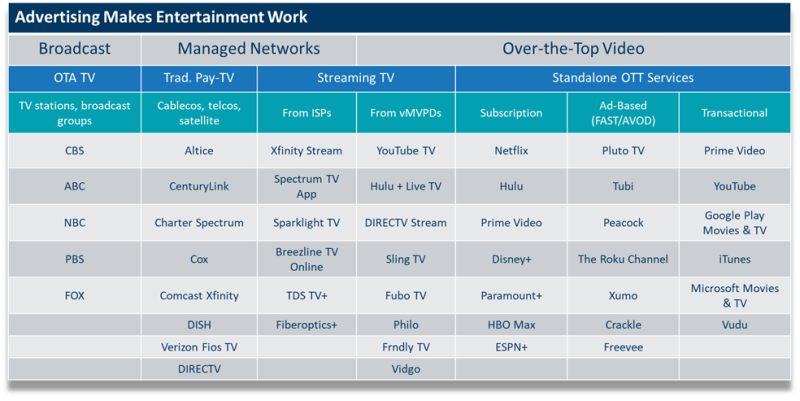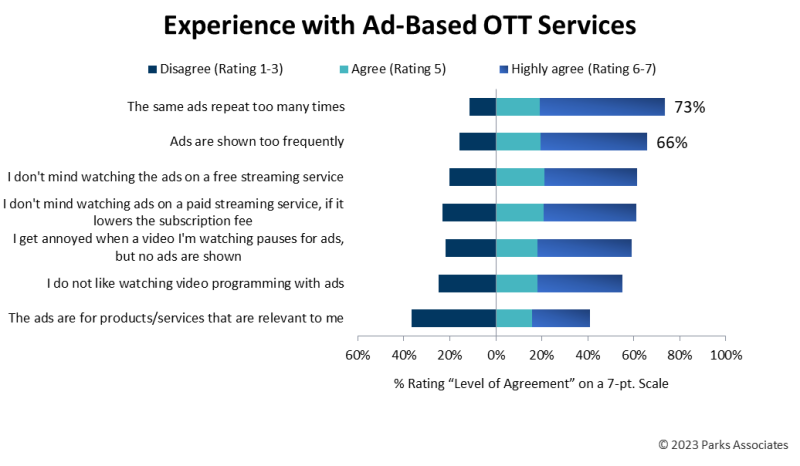
Streaming services supported by AVOD, FAST, and now SAVOD (Subscription Ad-supported Video on Demand) generate the majority of their revenue from the sale of advertisements that run during or adjacent to movies, television shows, and other programming, similar to traditional broadcast or pay-TV services.
It is worth highlighting just how fundamental advertising is to the media entertainment ecosystem. Across all video service offerings – including broadcast, traditional pay-TV, streaming TV, and direct-to-consumer streaming service options, most have traditionally incorporated some form of advertising.

Consumers are looking for less expensive ways to watch television, and ad-based services are delivering. 41% of US internet households are recently using ad supported AVOD or FAST services, a significant increase from 18% in 2018. The surge is even more pronounced for freemium services that offer both free, ad-supported, and premium paid tiers, aligning with the familiar lean-back linear experience, reflecting consumer spending adjustments in the current economic climate.

According to the Interactive Advertising Bureau (IAB), connected TV advertising expenditures reached $15.3 billion in 2021 (an increase of 57% from 2020) and $21.2 billion in 2022. According to media agency GroupM, CTV advertising is expected to be $25.9 billion by the end of 2023 globally and grow to $33 billion by 2026.
The sale of these ads can be managed by the streaming service, the owner of the content being streamed, a third party, or a combination of all three. Some services have built ad sales teams that sell ads on platforms other than their own. Historically, revenue has been split between the streaming platform and the content owner on a negotiated basis. As the advertising inventory rises, so do the revenues.
The ads are everywhere
In the early days of streaming, there was more content than there were ads or ad agencies willing to spend on streaming and connected TV content. Many streaming programmers were forced to run slates while in a commercial break, announcing that they would return immediately after the break. Slates caused churn but without the inventory, it was considered better than bars or a black screen. Unfortunately, commercial break slates continue to occur for some smaller niche services that struggle to secure advertising revenue. Today 89% of broadband households have at least one streaming service and advertising between content must be engaging in order to hold consumer’s interest.
The advertising landscape within streaming services has changed dramatically in recent years, owing to factors such as viewer preferences, technological advancements, and the service's need to earn a profit. Netflix and Disney have recognized the value of advertising revenue in their streaming services and have begun offering lower-cost ad-supported subscription tiers (SAVOD). As the digital marketplace for video services evolves, there's a notable shift towards ad‐based models by SVOD leaders to supplement revenue due to the growing market saturation. Apple TV+ and Prime Video are two of the last major services to remain somewhat ad-free. However, Prime Video will introduce ads in 2024, requiring members to pay an additional $2.99/month to remain ad-free. Also, Apple TV is having “exploratory” talks with executives in the media space to determine if it is feasible to launch a new advertising product for its streaming service.
Offering an AVOD service on a subscription basis (SAVOD) generates dual revenue streams. The challenge today is to ensure that consumers see the ads and do not turn away during them. Because each device used to watch streaming video is uniquely addressable, advertising can be targeted and measured better today than before. If the consumer skips the ad, jogs ahead, or, in some cases, pauses the program, the TV advertisement may not be viewed and data not included or counted, thus the service or program's revenue is significantly reduced. The streaming advertising community is looking to address this with new types of advertising commercials.
Advertising strategies to guarantee eyeballs
The evolution of advertising technology has introduced new ad formats, opportunities, and challenges for advertisers and streaming platforms alike. This advancement in ad tech is helping to ensure the ads are being seen by consumers, in turn generating revenue for the service.
- Unskippable Ads: is a notable innovation on YouTube, also known as "TrueView" advertisements. In May of 2023, YouTube TV launched a type of video advertisement that viewers cannot skip after the first five seconds.
Because viewers are required to view them in full before proceeding to the main video content, these advertisements are strategically designed to capture the audience's attention within the first few seconds. Unskippable ads can be a particularly effective tool for campaigns with a clear call to action, as they ensure that the audience sees the entire message without interruption. Peacock and Paramount+ also have their own forms of non-skippable 20-second preroll ads along with Disney+, and Netflix. While nonskippable advertisements can be effective, they are not without drawbacks. The viewer's perception of the ad and the brand it represents may be negatively impacted if they find the advertisement intrusive or annoying.
- Paused Ads: Hulu introduced paused ads in 2019. “The brief moment between pause and play can be a potent and noninvasive ad opportunity,” said Jeremy Helfand, Executive Vice President, Advertising & Data Platforms at The Walt Disney Company.
This strategy takes advantage of the moments when viewers pause their viewing to display targeted advertisements. The ad takes advantage of viewers' engagement with the content, giving advertisers a unique opportunity to capture the audience's attention in a non-intrusive manner. Paused ads represent a shift toward more personalized and interactive advertising strategies, which aligns with the growing demand for interactive viewing experiences. Just this month, Max, and Peacock announced they are introducing a 'pause ads' feature.
- T-Commerce Ads: T-Commerce is TV-based commerce, where a purchase is made in response to an advertisement or product placed in a video stream on the TV.
Consumers may buy goods through an interactive feature on the TV or through a second-screen app on a mobile or tablet device. Services such as Roku, Amazon, Peacock, and Netflix are actively engaged in T-Commerce ads. Parks Associates data shows that the vast majority - 88% - of US internet households shop online at least monthly. The just published study of 8,000 internet households in the US, T-Commerce: Buying Through the TV, explores the potential of T-commerce to generate additional revenues for video service providers and the effectiveness it may have in advertising brands and sales.
- In-stream Advertising: In-stream advertising allows brands to personalize in-platform ads based on the user's persona, collected viewing data, and past behavior. Social platforms, Instagram, TikTok, and Snap Chat do this well. YouTube also does this type of ad delivery, pulling data from the user's browser or previous history to serve an ad that is relevant and engaging to the user. In-stream ads can take various forms, such as video ads, audio ads, or display ads, and are intended to reach the audience while they are already consuming content in a non-disruptive manner.
- Dynamic Overlay/Interactive Advertising: Interactive advertisements are a type of advertising that encourages user interaction. Dynamic ads are display ads with the option to engage. These advertisements go beyond the traditional one-way communication of a message from the advertiser to the audience. Instead, they allow the viewer or user to interact with the advertisement in some way. This interaction can take various forms, such as clicking on elements within the ad, filling out forms, playing games, and signing up for newsletters or new services. The goal of interactive ads is to increase engagement and provide a more immersive experience for the consumer. We are seeing more of this interaction within live betting and sports content.
Consumers attitude towards advertising
The attitudes of consumers toward advertising are complex and multifaceted. Some consumers are skeptical of advertising and find them intrusive. They are aware of the persuasive intent behind advertisements and frequently examine them critically. On the other hand, some consumers can also have favorable attitudes toward advertising. Advertisements that are well-crafted and entertaining can capture their attention, engage them, or create an emotional connection with a brand.
A recent survey of 8,000 US internet homes conducted by Parks Associates in Q3 2023 indicates that the streaming industry has much work to do before consumers begin to appreciate advertising in streaming services. Most consumers believe the ads are repetitive and shown too often. 73% of consumers believe the same ads repeat too often, and 66% say there are too many ads in the content they are consuming.

Services evolve and so must the advertising
The dynamic and evolving streaming landscape is reflected in the changing environment of the types of advertising.
Innovative ad formats, such as unskippable, paused ads and T-commerce, are helping to boost engagement and drive sales. The proliferation of ad-supported services provides advertisers with more options for ad placement and a wider reach, while advances in data mining and analytics make it possible to run highly targeted and interactive advertising campaigns.
As the popularity of streaming services continues to rise, advertisers are being forced to adjust their strategies to effectively connect with their target audiences within the context of an ever-evolving digital ecosystem. The success of an AVOD, SAVOD, or FAST service is dependent on engaging relevant ads for the viewer which in turn drives ad revenue. If services do not leverage interactive advertising experiences, they are at risk of consumers churning out.
Eric Sorensen is the Director, Streaming Video Tracker, for Parks Associates, a market research and consulting company. He is an accomplished sports and news media executive with extensive knowledge in developing live streaming and Digital Media strategies. Eric spent over 15 years at ESPN helping pioneer the launch of WatchESPN, The Longhorn Network, and SEC digital network. Prior to joining Parks Associates Eric served as Director of Advertising and Digital and Social Content for the Houston Astros.
Industry Voices are opinion columns written by outside contributors—often industry experts or analysts—who are invited to the conversation by StreamTV Insider staff. They do not represent the opinions of StreamTV Insider.